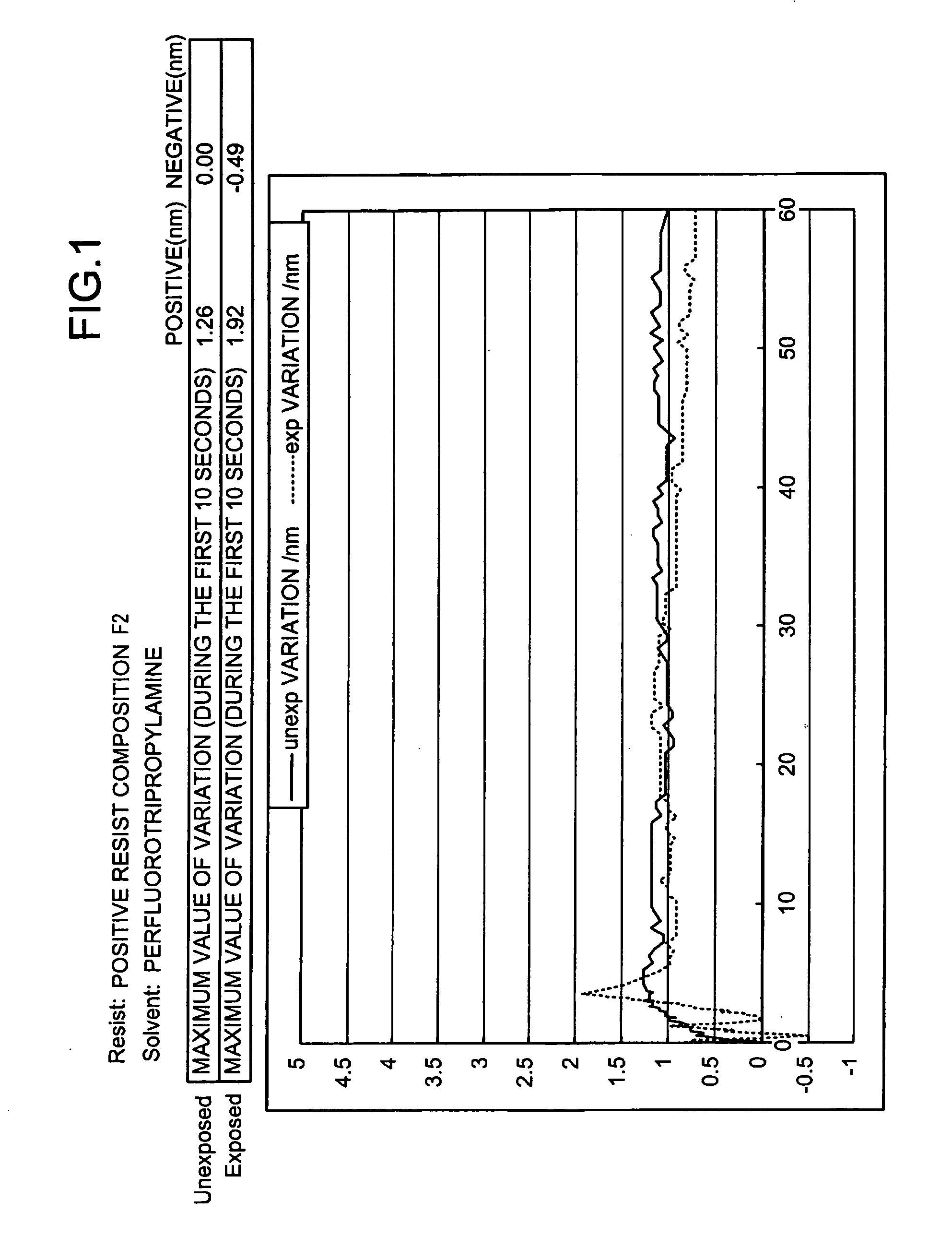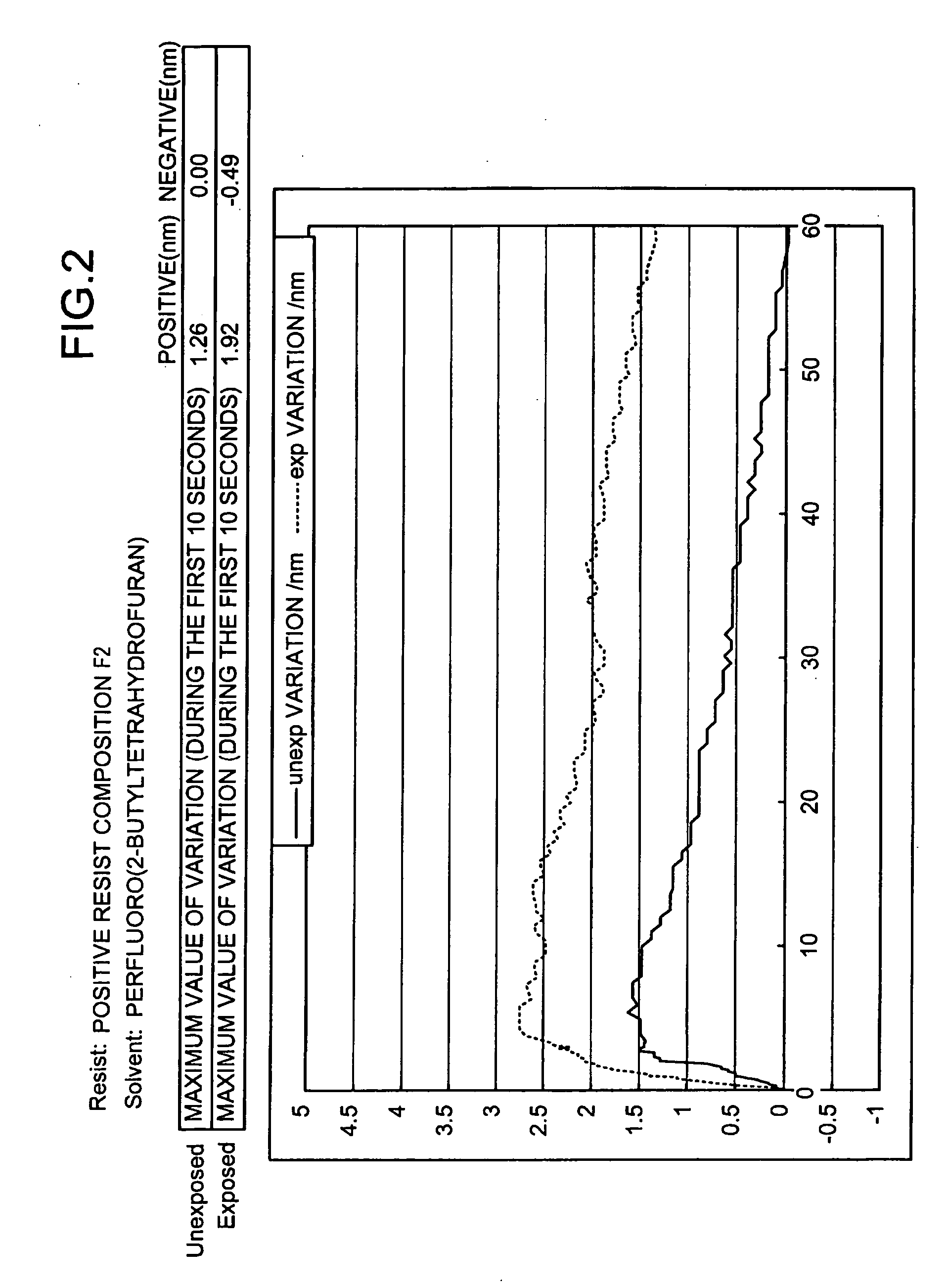Immersion fluid for use in liquid immersion lithography and method of forming resist pattern using the immersion fluid
a technology of immersion fluid and resist pattern, which is applied in the field of immersion fluid for use in liquid immersion lithography and the method of forming resist pattern using the immersion fluid, can solve the problems of only providing a decreased pattern resolution and lack of resistance to immersion fluid, and achieves improved resolution, high precision, and high sensitive
- Summary
- Abstract
- Description
- Claims
- Application Information
AI Technical Summary
Benefits of technology
Problems solved by technology
Method used
Image
Examples
example 1
[0217] In the manner described below, a resin component, an acid-generating agent and a nitrogen-containing organic compound are uniformly dissolved in an organic solvent to form a positive type resist composition 1.
[0218] The resin component used was 100 parts by weight of a methacrylate / acrylate copolymer composed of three structural units shown by the following chemical formulae (40a), (40b), and (40c). The structural units p, q, and r to form the resin component were used in proportions of 50 mol %, 30 mol %, and 20 mol %, respectively. The resulting resin component had a weight-average molecular weight of 10000.
[0219] The acid-generating agent used was 3.5 parts by weight of triphenylsulfonium nonafluorobutanesulfonate in combination with 1.0 part by weight of (4-methylphenyl)diphenylsulfonium trifluoromethanesulfonate.
[0220] The organic solvent used was1900 parts by weight of a mixed solvent of propyleneglycol monomethylether acetate with ethyl lactate (6:4 by weight ratio...
example 2
[0228] The same procedure was followed as in Example 1 to make a resist pattern, except that a photoresist composition 2 as described below was used.
[0229] The resin component used was 100 parts by weight of the structural unit shown by the following chemical formula (41). The resulting resin component had a weight-average molecular weight of 10000.
[0230] The acid-generating agent used was 3.5 parts by weight of triphenylsulfonium nonafluorobutanesulfonate in combination with 1.0 part by weight of (4-methylphenyl)diphenylsulfonium trifluoromethanesulfonate.
[0231] The organic solvent used was 1900 parts by weight of a mixed solvent of propyleneglycol monomethylether acetate with ethyl lactate (6:4 by weight ratio).
[0232] 0.3 parts by weight of triethanolamine was used as the nitrogen-containing organic compound.
[0233] The resulting resist film was 140 nm thick and the resist pattern had 90 nm line-to-space ratio of 1:1.
[0234] Scanning electron microscopy (SEM) of the resulting...
example 3
[0235] The same procedure was followed as in Example 2 to make a resist pattern with a 90 nm line-to-space ratio of 1:1, except that a photoresist composition 3, a negative type resist composition as described below, was used.
[0236] The resin component used was 100 parts by weight of a copolymer composed of two structural units shown in the following chemical formula (42). The two structural units were present in the resin component in proportions of m=84 mol % and n=16 mol %. The resulting resin component had a weight-average molecular weight of 8700.
[0237] 10 weight % (relative to the resin component) of tetrabutoxymethylated glycoluril to serve as the crosslinking agent, along with 1 weight % of triphenylsulfonium nonafluorobutanesulfonate in combination with 0.6 weight % of 4-phenylpyridine to serve as the acid-generating agent, were dissolved in a mixed solvent of propyleneglycolmonomethylether acetate and ethyl lactate to make a composition containing 8.1 weight % of the so...
PUM
| Property | Measurement | Unit |
|---|---|---|
| boiling point | aaaaa | aaaaa |
| boiling point | aaaaa | aaaaa |
| width | aaaaa | aaaaa |
Abstract
Description
Claims
Application Information
 Login to View More
Login to View More - R&D
- Intellectual Property
- Life Sciences
- Materials
- Tech Scout
- Unparalleled Data Quality
- Higher Quality Content
- 60% Fewer Hallucinations
Browse by: Latest US Patents, China's latest patents, Technical Efficacy Thesaurus, Application Domain, Technology Topic, Popular Technical Reports.
© 2025 PatSnap. All rights reserved.Legal|Privacy policy|Modern Slavery Act Transparency Statement|Sitemap|About US| Contact US: help@patsnap.com



